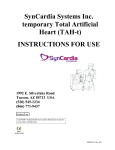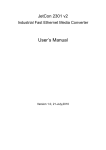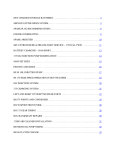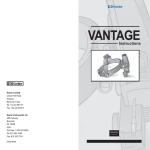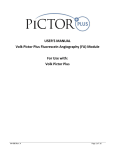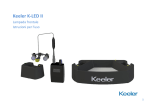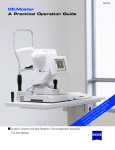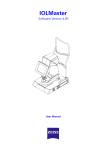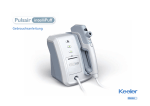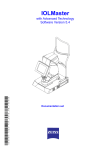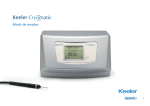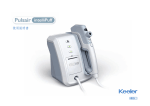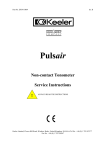Download Keeler IntelliPuff User Manual English
Transcript
Instructions for use Home Back Next Contents 1. Copyright and Trademarks 11. Preparing the patient 2. Introduction 12. Taking the reading 3. Symbols 13. Display examples 4. Warnings and cautions 14. Printing 5. Cleaning instructions 15. Replacing the printer paper 6. Power supply assembly 16. User menu options 7. Wall mounting 17. Calibration, maintenance and inspection 8. Tonometry pressure variations in the human eye 9. Names of controls and components 18. Specifications and electrical ratings 19. Accessories 20. Contact and disposal information 10. Measurement procedures Please click on the contents to go straight to your chosen section or navigate by using the 'Next' and 'Back' buttons to the right. Clicking on 'Home' will bring you back to this page. As part of our policy for continued product development we reserve the right to amend specifications at any time without prior notice. Home Back Next Copyright and Trademarks The information contained within this manual must not be Description of the product reproduced in whole or part without the manufacturer’s prior The Keeler Pulsair intelliPuff is an “air puff” Tonometer designed written approval. to accurately measure Intra Ocular Pressure (IOP) without making contact with the surface of the eye. The manufacturer reserves the right to make changes to specifications and other information contained in this document Air impulse tonometry is a variant of the general applanation without prior notice. tonometry in which a portion of the cornea is flexed by mechanical stimuli in which the force/pressure required to Pulsair intelliPuff™ is a registered Trademark of produce the flexing effect is related to the intraocular pressure. Keeler Limited 2007. The air puff technique requires directing a calibrated quantized Copyright © Keeler Limited 2007. packet of air towards the central portion of the cornea, and the detection of the pre-defined deformation of the cornea through Published in the UK. April 2007. optical means and reflections from the corneal surface. Please read and follow these instructions carefully. Home Back Next Introduction Thank you for purchasing the Keeler Pulsair intelliPuff™. The product has been designed and manufactured to ensure that you will enjoy many years of trouble free and safe use. Please follow the User Instructions to ensure optimum performance. Home Back Next Symbols Read user instructions for Warnings, Cautions and additional information. The CE mark on this product indicates it has been 0088 tested to and conforms with the provisions noted within the 93/42/EEC Medical Device Directive. Double insulated. Type BF protections against shock. Home Back Next Warnings and cautions Caution Warning • Do not use if the product is visibly damaged and periodically • The product has been designed to function safely when at an inspect for signs of damage. ambient temperature between +10ºC and +35ºC. • Do not use in the presence of flammable gases. • Use correct Keeler power supply. • This product should not be immersed in fluids. • Keep out of the reach of children. • Do not fit mains power adapter into a damaged mains • To prevent condensation from forming, allow instrument to outlet socket. come to room temperature before use. • Route power cords safely to eliminate risk of tripping or • Only mount on wall according to Keeler Instructions. damage to user. • Federal law restricts this device to sale by or order of a physician. • Only use approved Keeler power supply EP39-32777 Home Back Next Cleaning instructions Only manual non-immersion cleaning as described should be used for this instrument. Do not autoclave or immerse in cleaning fluids. Always disconnect power supply from source before cleaning. a Wipe the external surface with a clean absorbent, non- shedding cloth dampened with a water / detergent solution (2% detergent by volume) or water / isopropyl alcohol solution (70% IPA by volume). Avoid optical surfaces. b Ensure that excess solution does not enter the instrument. Use caution to ensure cloth is not saturated with solution. c Surfaces must be carefully hand-dried using a clean non- shedding cloth. d Safely dispose of used cleaning materials. Home Back Next Power supply assembly Set Plug Replace the blanking plate with the appropriate mains plug adapter if required, or use IEC 60320 TYPE 7 connector (not supplied). IEC 60320 TYPE 7 connector Home Back Next Wall mounting Your Pulsair intelliPuff is supplied with a sturdy wall mounting bracket. 1. The bracket has four holes allowing it to be securely fixed to an appropriate wall or vertical surface. 2. Choose carefully the intended location for your intelliPuff with particular consideration to health and safety aspects, for example the routing of the power lead, and it’s position in regard to the user and the patient. 3. Use the wall mounting bracket as a template and clearly mark the position of the holes in the wall. Ensure that there are no live utilities where you are to drill. 4. Drill the appropriate size holes for the screws and rawplugs supplied. 5. Attach the plate securely to the wall. 6. Carefully locate the mounting pegs of the plate to the key holes on the back of your Pulsair intelliPuff and allow the Pulsair be lowered into its final and secure position. Home Back Next Tonometry, pressure variations in the human eye The Keeler Pulsair intelliPuff measures intra-ocular pressure by automatically releasing a gentle puff of air onto the cornea. This is known as an event. An single reading can sometimes be misleading as the IOP will vary as a result of pulse, respiratory and diurnal fluctuations. In addition blinking, squeezing, fluid intake, physical activity, body position and even the direction of gaze can influence IOP. Up to 4 readings may be required in order to reduce the impact of these variants to a constant IOP. Pulsair intelliPuff software will recognise the readings and give a sound notification when two consecutive readings are +/1mmHg of each other indicating that further measurements may not be required. Home Back Next Names of controls and components 1. On off push button 7. Forehead rest To turn the intelliPuff on, push the on off button – Push to release, or push to return the a green LED will indicate the unit is on. forehead stabiliser to its discrete position. To turn off the intelliPuff, push the on off button – the green LED will go out. 2. Test eye This is useful for user training; it will not return an IOP measurement. 7 8. Right (OD) / Left (OS) indicators These will indicate the eye to be measured; the OD/OS button will toggle between these indicators. 3. Printer active LED When lit, this indicates the printer is activated; replacing the handset in the cradle will force a print. Alternatively a print can 2 be forced at any time using the print button on the handset. 1 8 3 4. Printer cover Access to the printer paper is via this cover, use your finger in the lip on the top of the cover and gently pull towards you to open the printer cover. 4 5. Serial port 5 The serial port is used for calibration, systems checking and 6 data output (located on rear of instrument). 6. Power input Insert the low voltage power lead (located on rear of instrument) use only Keeler power supplies. Home Back Next Names of controls and components 9. Display When all the required readings have been taken the figure The display shows the recorded IOP reading and the averaged displayed is the IOP that is recorded for the patient. IOP reading. When two consecutive readings are within 1mmHg an audible sound will be heard indicating that sufficient readings may After the first reading is taken the display shows the measured IOP. After each of the consecutive reading is taken the display shows the average of the readings taken so far, i.e. the first figure displayed is the actual reading, the second figure is an average of the first two readings etc., up to a maximum of 4 readings per eye. Note: The displayed figure is rounded to the nearest whole number or displayed to one decimal place depending on the user setting accessed via the menu. The displayed average is based on the actual readings which are taken to one decimal place. For example, readings of 15.4, 16.3, 14.2 and 16.9 are averaged by adding them together which equals 62.8 and dividing by the number of readings taken, 4. This gives a final figure of 15.7, or 16 depending on user settings. have been taken. 9 8 Home Back Next Names of controls and components Main control buttons 10.Print / Menu button A press of less than one second will print the acquired data; press and hold for more than 3 seconds to access the menu and sub menu functions. 11.Review button 13.OD / OS button ‘Menu Change button’ This toggles between recording data for the left or right eyes. This button also is used to toggle through 11 12 the menu options when in 13 menu mode, refer to section 17 for full instructions. 15 14 10 16 You can review the readings taken at any time: Press the Review button. The display shows the readings taken in the order they were taken, the final figure 14.Eyepiece displayed is the cumulative average, the IOP. The Eyepiece allows the user to view the patient’s eye and The Pulsair memory is retains a rolling four readings, per align the targeting system. eye. New readings automatically replace the oldest. To review the other eye, press the OD/OS button once The puff tube and puff lens is the part of the Pulsair intelliPuff and then press the review button. through which the Pulsair is aligned and a gentle puff of air is To clear the memory you can either replace the hand unit in emitted. the holster and remove again or press the Demo button. 12.Demo button The demo button will produce a sample puff to demonstrate to a patient the softness of the puff and alleviate any apprehension. 15.Puff tube and lens 16.Alignment LEDs The two green LED’s located on the front of the hand unit act as a guide when you are lining up the patients eye to take a reading. Home Back Next Measurement procedures 4 5 Prepare the device 2 6 1. Plug in the power supply cord to the instrument. The power socket is located at the rear of the instrument. 3 2. Turn the instrument on using the on off push switch located on the front of the instrument. 3. Lift the handpiece from the cradle. 1 4. Remove the red protective dust cap from the puff tube. 5. When the hand unit is removed from the holster the two green LED’s on the front illuminate, and the pump starts, the intelliPuff will perform a system check, when complete the display will read ‘OK’, refer to section 14 for a full list of display data. 6. Before using the Pulsair intelliPuff press the Demo button to dispel any minute particles of dust or moisture which may have settled whilst the Pulsair intelliPuff was not in use. Pull out short form instructions 7 7. Align the handpiece with the patients cornea – the Pulsair will automatically fire when correctly aligned. Note: For quick alignment reference, please refer to the short form instructions located at the rear of the instrument and accessed by using the pull out tab on the back left hand side. Home Back Next Preparing the patient Before using the Pulsair intelliPuff you should make your patient Before taking a reading you should: feel at ease and ensure they are located in an optimum reading location, preferably with their head supported. This is because 1. Ask the patient to blink to ensure a good and reflective apprehension and nervousness may adversely affect the readings tear film. obtained. Follow the points outlined below to achieve this: 2. Ensure the patient and instrument optics are not positioned 1. Ensure that the patient is comfortable and in a relaxed under direct lighting (i.e. spot lights or sunlight). position. 3. Ensure the patient’s eyes are fully opened. This helps to 2. Ask the patient to remove their contact lenses or spectacles if prevent squeezing, where the patient unconsciously tenses their eyelids and increases IOP. worn and to blink and breathe normally. 3. In order to reassure the patient, you can demonstrate the 4. Throughout the reading process, you should: procedure, using the Demo button, on the back of the Allow the patient to blink at intervals in order to maintain patient’s hand prior to taking a reading. the corneal tear film. Home Back Next Taking the reading Once the Pulsair intelliPuff and the patient are prepared, you are ready to take a reading. 7. Move closer. At a distance of approximately 15mm, a black cross on red or ‘bow tie’ image appears. 1. The Pulsair intelliPuff is set to automatically select the right Centre this image (on the central bar) and the eye as the first eye to be measured. If you wish to select the Pulsair intelliPuff fires. left eye, press the OD/OS button on the hand unit. 8. Once you have taken a reading, remain in the operating position; 2. Lift the hand unit, the pump starts and the two green LED’s wait a few seconds for the air chamber to refill. When the ‘bow tie’ image appears Pulsair intelliPuff takes a subsequent reading. When two successive readings within 1mmHg of each other 3. From a distance of about 30 cms (12 inches), look are recorded, a sound may be emitted (if sounds are enabled in the menu settings). If successive readings of within 1mmHg of each other are not obtained, Keeler recommend taking up to four readings. illuminate. through the eyepiece and locate the patient’s eye. 4. Slowly move closer to the patient, maintaining alignment. Support the Pulsair intelliPuff against your free hand and/or use the ‘pop out’ forehead stabilizer. Continued on next page 5. Continue to move in slowly towards the patient, two green dots appear. 6. Continue to move closer, a red reflex appears. Home Back Next Taking the reading 9. When two consecutive readings are within 1mmHg an audible sound will be heard indicating that sufficient readings may have been taken. 10.If a reading is recorded as a non event or bad event, a bad event long high pitch tone will be heard. 11.The first reading will be the measured value; successive readings will display the running average IOP. Outlying or spurious readings will automatically be excluded from the calculation. 12.At any time the review button will allow you to view the individual readings. 13.If the unit does not fire, repeat step 3-7. To measure the other eye, press the OD/OS button on the hand unit and repeat processes 3 - 7. Home Back Next Display examples The unit will display STBY when power is on. When a pressure (IOP) of greater than 25mmHg is detected, the unit will display >25, the puff intensity will automatically be increased from the soft puff to the normal puff level for subsequent measurements. The unit will display ‘wait’ for one second while the system initialises. The unit will perform regular self tests – if a possible discrepancy When no fault is found, OK is displayed and the unit in operating parameters is suspected the ‘run self test’ message defaults to measure the right eye OD. will be displayed for up to 15 seconds. To continue to use the unit press the OD/OS button to clear the message. The results displayed thereafter may be suspect. Refer to the user menu options section in this manual for guidance on running the self test. Shows first reading of 14mmHg. The LED OD/OS indicator shows which eye the reading relates to. Display shows error. (Signified by a long high pitch sound). If 0.1 significant figure is selected using the menu options. In this case there is no indication on the display that the reading is the first or average of more than 1. Home Back Next Printing The results can be printed by pressing the print button on the handpiece, or if the user menu is set to automatically print by replacing the handpiece in the cradle. Sample print Name: The reading in brackets (20) indicates a discarded value (not Date: taking into account in the average calculations). Time: The Name, Date and Time fields are to be manually written in by Right Eye: the operator. Avg IOP: 10.4 mmHg Data: (20), 10, 10, 10 Average is printed in XX.X and data in only 2 digits. Only the last 4 of data on each eye are printed. Left Eye: Avg IOP: 10.5 mmHg Data: 10, 11, 10, 10 Home Back Next Replacing the printer paper 1. Access to the printer paper is via the printer cover, use your finger in the lip on the top of the cover and gently pull towards you to open the printer cover. Remove the empty paper roll. 2 3 2. Place the new roll of paper into the paper holder, making sure the free end is loose at the top of the roll. 3. Feed the free end of paper through the gap in the cover. 4. Close the cover. 1 Home Back Next User menu options 1. With the unit switched on and the handpiece removed, press and IntelliPuff levels Clinical (CLIN) Clinical mode will give the most accurate IOP hold menu button for more than 3 second to enter the user menu. 2. The display will show the first user option and the current selection i.e. [prnt off] or [prnt on]. measurement possible with this hand-held Tonometer. In this mode, precise alignment is essential in order to satisfy the firing criteria. It is recommended to set the IOP format to xx.x when 3. To change the user option, press the CHANGE button once, in this mode. ‘toggling’ the CHANGE button will cycle through the option(s). 4. Pressing the MENU (print) button will move you forward to the next user option, in this case the buzzer control. Auto (AUTO) Auto mode will automatically reduce the alignment sensitivity of the Pulsair when there is some difficulty in achieving the firing criteria. AUTO mode is the default setting. 5. Use the CHANGE (OD/OS) button to make your preferred selection. Note: to run the self test press the DEMO button, not the CHANGE button. The last choice above “Run Test” 6. Continue to repeat steps 4 and 5 until ‘OK’ is displayed, your (Selected by pressing Demo button) would start a self test program Pulsair intelliPuff is now ready to use with your preferred settings. (around 45 seconds), the result of Menu option Display Change options Printer control PRNT OFF / ON Buzzer control BUZ ON / OFF intelliPuff level Puff CLIN (clinical) AUTO IOP Format IOP: XX / XX.X Full self test Run Test/wait which should be printed. MENU CHANGE DEMO BUTTON Home Back Next Calibration, maintenance and inspection Clean the puff tube lens on a weekly basis: 1. Moisten a cotton bud with Isopropyl Alcohol. 2. Move the tip of the bud around the lens in a circular motion. 3. After one circle the bud should be discarded to avoid smearing on the lens. 4. Look at the puff tube lens from the patient’s side, if traces of tear film can still be seen, repeat above steps until clear. Note: Care should be taken not to damage the Puff Tube Regular inspection assembly during cleaning. Inspect your power supply unit and cable for damage regularly. Caution Before inspecting, disconnect the power supply from the Pulsair Never use a dry cotton bud or tissue to clean the puff tube lens. intelliPuff and the mains. Never use a silicone impregnated cloth or tissue to clean the puff tube lens. If the outer insulation of the cable appears to be damaged discontinue use immediately. Contact your local dealer for a External cleaning replacement. Keep the unit free of dust. Home Back Next Calibration, maintenance and inspection General Keep the instrument free from dust. If the unit is to remain unused for any length of time, turn the On off push button switch to Off and remove the power supply. Use the dust cover to protect the unit. Before using the Pulsair intelliPuff again, press the Demo button to dispel any minute particles of dust. Servicing and calibration Keeler recommends an annual calibration for the Tonometer. This must be performed by an authorised Pulsair service centre or distributor. The unit performs a self function check when switched on and will indicate if a fault is found. Home Back Next Specifications and electrical ratings Console dimensions 260 x 215 x 220mm (H x D x W) Hand Unit dimensions 315 x 150 x 46mm (H x D x W) Console weight 2.465Kg Hand Unit weight 0.890Kg Calibrated range 5mmHg to 50mmHg Displayed accuracy 0.1mmHg Working distance 20mm from surface of patient’s cornea to front surface of first lens. This equates to a nominal distance of 15mm from the front of the puff tube shroud to the front surface of the patient’s cornea Displayed scale 4 character dot matrix scrolling Illumination system LED infra red Length of umbilical cord 2 M Complies with Safety (Medical) EN 60601-1:1990 plus amendments A1:1993, A11:1993, A12:1993, A2:1995 and A13:1996. EN ISO 15004:1998, Clause 6.3 optical radiation hazard, Clause 7.3 environmental conditions. EN60601-1-2 for EMC Power Supply Unit Switch mode, (110 – 240V)+/- 10% multi plug type compliant to EN 60601-1 EN 61000-6-2, EN 61000-6-3 Power supply output 30 VA (12V DC 2.5A) Frequency 50/60 Hz Home Back Next It is well established that exposure of the eye to intense light sources for extended periods of time poses a risk of retinal photic injury. Many ophthalmic instruments illuminate the eye with intense light. The light levels on the Pulsair have been set at the lowest level possible. No visible retinal lesions have been identified as a result of using Pulsair tonometers, however, young children and persons with diseased eyes may be at a higher risk. The risk may also be slightly Relative output / Arbitrary Units Specifications and electrical ratings 1 0.8 Red LED 0.6 Green LED 0.4 0.2 0 1100 300 400 500 600 700 800 900 1000 1100 Wavelength / nm increased if the person being examined has had any exposure with the same instrument or an other ophthalmic instrument Figure 1: Spectral irradiance of instrument at user plane using an intense visible light source during the previous 24 hours. This will apply particularly if the eye has been subjected to retinal photography. Note: This device complies with EN60601-1-2 for EMC, and should not present problems to other equipment or be affected by other devices. As a precaution, avoid using this device in close proximity to other equipment. Photochemical source radiance Source Radiance (mW cm-2 sr-1) Aphakic, LA (305-700nm) Red LED 3.22 Phakic, LB (380-700nm) Red LED 3.20 Aphakic, LA (305-700nm) Green LED <0.01 Phakic, LB (380-700nm) Green LED <0.01 Table 2: Calculated photochemical source radiances Home Back Next Accessories Accessories supplied Dust cover Printer paper Puff tube dust cap Wall mounting bracket User manual (printed / CD depending on market) Quick user guide/pull out card Consumable Printer paper Home Back Next Contact Information Manufacturer Scotland Sales Office USA Sales Office Keeler Limited Clewer Hill Road Windsor Berkshire SL4 4AA Keeler Scotland 25 Deerdykes View Westfield Estate Cumbernauld G68 9HN Keeler USA 456 Parkway Broomall PA 19008 USA Freephone: 0800 521251 Tel: +44 (0) 1753 857177 Fax:+44 (0) 1753 827145 Freephone: 0800 521251 Tel: +44 (0) 1236 721214 Fax:+ 44(0) 1236 721231 Toll Free: 1 800 523 5620 Tel: 1 610 353 4350 Fax:1 610 353 7814 Disposal of old Electrical and Electronic Equipment (Applicable in the European Union and other European Countries with To Reduce the Environmental impact of WEEE (Waste Electrical Electronic separate Collection Systems). Equipment) and minimise the volume of WEEE entering landfills we encourage at Product end of life that this Equipment is recycled and reused. This Symbol on the Product or on its Packaging and instructions indicates that it was put on the market place after August 2005 and If you need more information on the collection reuse and recycling then that this product shall not be treated as Household Waste. please contact B2B Compliance on 01691 676124 (+44 1691 676124). 0088 EP59-70004 Issue B Home Back Next



























